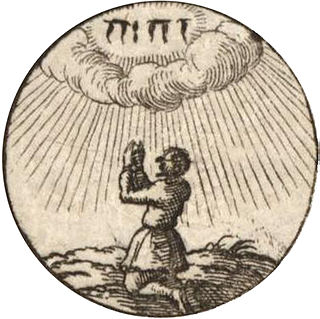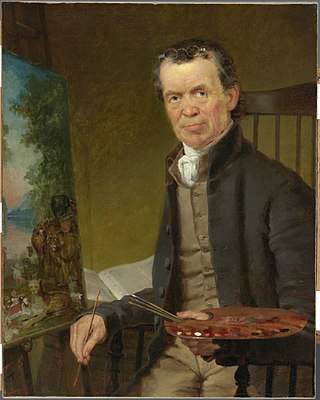Related Research Articles

The priesthood of all believers is either the general Christian belief that all Christians form a common priesthood, or, alternatively, the specific Protestant belief that this universal priesthood precludes the ministerial priesthood found in some other churches, including Catholicism and Eastern Orthodoxy.

The Syriac Orthodox Church, also known as West Syriac Church or West Syrian Church, officially known as the Syriac Orthodox Patriarchate of Antioch and All the East, and informally as the Jacobite Church, is an Oriental Orthodox church that branched from the Church of Antioch. The bishop of Antioch, known as the patriarch, heads the church and possesses apostolic succession through Saint Peter, according to sacred tradition. The church upholds Miaphysite doctrine in Christology, and employs the Liturgy of Saint James, associated with James the Just. Classical Syriac is the official and liturgical language of the church.
The Patriarch of Antioch is a traditional title held by the bishop of Antioch. As the traditional "overseer" of the first gentile Christian community, the position has been of prime importance in Pauline Christianity from its earliest period. This diocese is one of the few for which the names of its bishops from the apostolic beginnings have been preserved. Today five churches use the title of patriarch of Antioch: one Oriental Orthodox ; three Eastern Catholic ; and one Eastern Orthodox.

Severus the Great of Antioch, also known as Severus of Gaza or the Crown of Syrians, was the Patriarch of Antioch, and head of the Syriac Orthodox Church, from 512 until his death in 538. He is venerated as a saint in the Oriental Orthodox Church, and his feast day is 8 February.

Inward light, Light of God, Light of Christ, Christ within, That of God, Spirit of God within us, Light within, and inner light are related phrases commonly used within the Religious Society of Friends (Quakers) as metaphors for Christ's light shining on or in them. It was propagated by the founder of the Quaker movement, George Fox, who "preached faith in and reliance on 'inward light' ". The first Quakers were known to sit in silence and meditate on the words of the Bible until they felt the inward light of God shining upon them and the Holy Spirit speaking. The concept was highly important to early Quakers, who taught: "God reveals Himself within each individual's conscience and consciousness by the Holy Spirit, Christ Himself being the Light to illuminate man's sinfulness and lead in the way of truth and righteousness. ... this light is in all men by the grace of God to lead them to Christ, and that the same light will give daily guidance to the Christian."
Sanctification literally means "to set apart for special use or purpose", that is, to make holy or sacred. Therefore, sanctification refers to the state or process of being set apart, i.e. "made holy", as a vessel, full of the Holy Spirit of God. The concept of sanctification is widespread among religions, including Judaism and especially Christianity. The term can be used to refer to objects which are set apart for special purposes, but the most common use within Christian theology is in reference to the change brought about by God in a believer, begun at the point of salvation and continuing throughout the life of the believer. Many forms of Christianity believe that this process will only be completed in Heaven, but some believe that complete entire sanctification is possible in this life.

Ignatius Zakka I Iwas was the 122nd reigning Syriac Orthodox Patriarch of Antioch and All the East and, as such, Supreme Head of the Universal Syriac Orthodox Church. Also known by his traditional episcopal name, Severios, he was enthroned as patriarch on 14 September 1980 in St. George's Patriarchal Cathedral in Damascus. He succeeded Ignatius Ya`qub III. As is traditional for the head of the church, Mor Severios adopted the name Ignatius.

Edward Hicks was an American folk painter and distinguished religious minister of the Society of Friends. He became a notable Quaker because of his paintings.
Miaphysitism is the Christological doctrine that holds Jesus, the "Incarnate Word, is fully divine and fully human, in one 'nature' (physis)." It is a position held by the Oriental Orthodox Churches and differs from the Chalcedonian position that Jesus is one "person" in two "natures", a divine nature and a human nature (dyophysitism).

Syriac literature is literature in the Syriac language. It is a tradition going back to the Late Antiquity. It is strongly associated with Syriac Christianity.

In Christian theology, the doctrine of incarnation teaches that the pre-existent divine person of Jesus Christ, God the Son, the second person of the Trinity, and the eternally begotten Logos, took upon human nature and "was made flesh" by being conceived in the womb of a woman, the Virgin Mary, also known as the Theotokos. The doctrine of the incarnation then entails that Jesus was at the same time both fully God and fully human.

Quakers are people who belong to the Religious Society of Friends, a historically Protestant Christian set of denominations. Members of these movements are generally united by a belief in each human's ability to experience the light within or "answering that of God in every one". Some profess a priesthood of all believers inspired by the First Epistle of Peter. They include those with evangelical, holiness, liberal, and traditional Quaker understandings of Christianity. There are also Nontheist Quakers, whose spiritual practice does not rely on the existence of God. To differing extents, the Friends avoid creeds and hierarchical structures. In 2017, there were an estimated 377,557 adult Quakers, 49% of them in Africa.
Athanasius II Baldoyo, also known as Athanasius of Balad, and Athanasius of Nisibis, was the Patriarch of Antioch and head of the Syriac Orthodox Church from 684 until his death in 687.

The Monastery of Saint Mary El-Sourian is a Coptic Orthodox monastery located in Wadi El Natrun in the Nitrian Desert, Beheira Governorate, Egypt. It is located about 500 meters northwest of the Monastery of Saint Pishoy.
The Aphthartodocetae, also called Julianists or Phantasiasts by their opponents, were members of a 6th-century Non-Chalcedonian sect. Their leader, Julian of Halicarnassus, taught that Christ's body was always incorruptible and only appeared to corrupt and exhibit blameless passions. This was in disagreement with another Non-Chalcedonian leader, Severus of Antioch, who insisted that Christ's body was passible, truly manifested blameless passions, was corruptible, and only became incorruptible following the resurrection.
Saint Ephraim of Antioch, also known as Saint Ephraim of Amida, was the Patriarch of Antioch, and head of the Greek Orthodox Church of Antioch, from 527 until his death in 545. He is venerated as a saint in the Eastern Orthodox and Catholic Churches. His feast day is 8 June.

William Penn was an English writer, religious thinker, and influential Quaker who founded the Province of Pennsylvania during the British colonial era. Penn, an advocate of democracy and religious freedom, was known for his amicable relations and successful treaties with the Lenape Native Americans who had resided in present-day Pennsylvania prior to European settlements in the state.
Severus II bar Masqeh was the Patriarch of Antioch and head of the Syriac Orthodox Church from 667/668 until his death in 684. He is commemorated as a saint by the Syriac Orthodox Church.
The Council of Manzikert met in 726 to reconcile the Armenian Apostolic and Syriac Orthodox churches. It was convoked by the Armenian catholicos John of Odzun and attended by many Armenian bishops and six bishops of the Syriac church sent by Patriarch Athanasius III. It took place in Manzikert (Manazkert).

John 1:9 is the ninth verse in the first chapter of the Gospel of John in the New Testament of the Christian Bible.
References
- ↑ Samuel M. Janney History of the religious society of Friends 1859 - Page 72 "This holy and redeeming power, he usually called by the scriptural term, 'the light of Christ,' for he is "the true light that lighteth every man that cometh into the world." "
- ↑ Barry L. Davis The Claims of Christ: What Jesus Had to Say about Himself 2001 Page 55 "said: 'Wake up, O sleeper, rise from the dead, and Christ will shine on you'” (Eph. 5:13-14). The knowledge we gain of ourselves is this: we are inherently evil and are resistant to the light of Christ because that light exposes all of our sins..."
- ↑ Byzantinoslavica - Volume 56 1995- Page 696 "Ephrem the Syrian, an apologist for this concept in the fourth century,44 and later especially Severus of Antioch in the sixth century, wrote extensive commentaries on the concept of the light of Christ, each from his viewpoint concerning on ..."
- ↑ The Papers of William Penn: William Penn's published ... William Penn, Mary Maples Dunn, Richard S. Dunn - 1986 - Page 156 "WP's part of Christian-Quaker might well have been entitled "The Light Within," for that is what of the essay is about. He began by defining the concept of the Light of Christ Within, adding that "Seed, Light, Word, Spirit, Life, Truth, Power, ..."